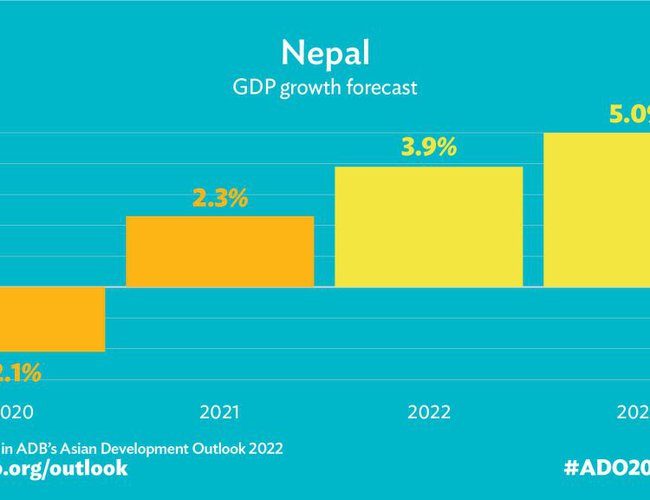
Nepal’s economy is anticipated to grow by 3.9% (at market prices) in fiscal year (FY) 2022 from an estimated 2.3% growth in FY2021, says the latest Asian Development Outlook (ADO) 2022, the flagship economic publication of the Asian Development Bank (ADB), and its Macroeconomic Update.ADB Link
Growth is expected to rebound on the back of the ongoing vaccination campaign against the coronavirus disease (COVID-19) pandemic to control infections, fostering a gradual normalization in economic activity and a steady path to higher growth supported by accommodative macroeconomic policies.
“However, slowing growth in advanced economies exacerbated by the Russian invasion of Ukraine, along with disrupted trade flows and higher oil and other commodity prices, is expected to push inflation and may exert further pressure on Nepal’s balance of payments and foreign exchange reserves,” said ADB Country Director for Nepal Arnaud Cauchois.
Agriculture was previously expected to grow favorably as paddy plantation had been promising amid abundant rainfall during the 2021 summer monsoon. However, unexpected rains and floods in mid-October damaged ready-to-harvest crops, which shrank paddy output by about 9.0% this fiscal year. Industry growth is expected to edge up to 4.1% in FY2022 on increased consumer and investment demand. Services will likely grow by 5.2% as wholesale and retail trade, transport, and financial services have picked up. International tourism remained depressed in 2021 but will likely gradually recover if the COVID-19 situation remains under control.
Inflation in FY2022 is forecast to average 6.5%, up from 3.6% in FY2021, reflecting the transmission of higher global oil prices and subsequent higher transportation costs. The recent uptick in petroleum and commodity prices, owing to the Russian invasion of Ukraine, has added further inflationary pressure. The current account deficit is expected to further widen to 9.7% in FY2022 from 8.0% of gross domestic product (GDP) in FY2021 due to increased import growth, a low export base, and subdued workers’ remittances.

GDP growth at 5.0% is envisaged for FY2023 on the expectation that vaccination against COVID-19 will continue to progress, enabling further revival of economic activities that have gradually picked up since FY2021. Inflation is forecast to marginally decline to 6.2% in FY2023, reflecting a better harvest, smoother supply chain distribution, relatively subdued oil prices, and a modest decline in India’s inflation. The current account deficit is expected to moderate to 6.1% of GDP in FY2023 as monetary policy is likely to be less expansionary, COVID-19-related imports will have substantially decreased, and increased hydroelectricity generation eases fossil fuel consumption.
Downside risks to the outlook center on exogenous shocks such as emergence of strong, new coronavirus variants, intensification of the current global turmoil, and recurrence of calamities like floods, landslides, and earthquakes, which have devastated lives and livelihoods in the past.
ADB is committed to achieving a prosperous, inclusive, resilient, and sustainable Asia and the Pacific, while sustaining its efforts to eradicate extreme poverty. Established in 1966, it is owned by 68 members—49 from the region.
- The Sentiment Of Monetary Policy Seems Focused On Increasing Eemand: FNCCI President Chandra Prasad Dhakal
- Jul 26, 2024
- Monetary Policy 081/82 Is Making The Economy More Dynamic: Governor Adhikari
- Jul 26, 2024
- Global IME Bank And Shashila Motors Signed Agreement Regarding Electric Vehicle loan
- Jul 26, 2024
- Lok Bahadur Thapa, permanent representative of the UN in New York, was appointed as the Vice President of ECOSOC
- Jul 26, 2024
- Leeladevi Gadtaula Became The First woman Chief Secretary
- Jul 26, 2024
















